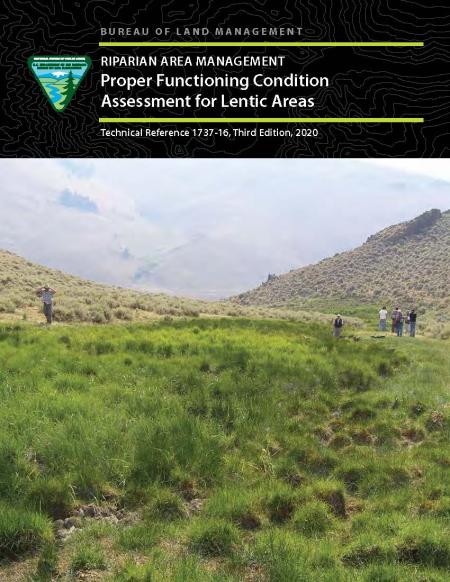Proper Functioning Condition Assessment for Lentic Areas

BLM Technical Reference 1737-16
This document provides guidance for completing PFC assessments on lentic areas. The distinction between lotic and lentic systems, however, is not always readily apparent. Sometimes functions vary by season such that the site behaves or resembles a lotic site for part of the year and a lentic site at other times. Although two discrete systems are described, the boundary between them can be blurry in some situations. When there is a degree of ambiguity, assessment items from the lotic and lentic protocols may be blended to create a customized or hybridized protocol that best fits an unusual and specific situation. Riparian-wetland areas are complex, dynamic ecosystems incorporating biological, physical, and chemical processes. The PFC assessment method was created to evaluate the foundation of these processes qualitatively—specifically, the functionality of the physical processes occurring in a riparian-wetland area. These physical processes include the interactions of hydrology, stabilizing vegetation, and geomorphology (soils and landforms). A quality assessment requires that an interdisciplinary (ID) team with expertise in these subjects assess the riparian-wetland area together. Because the PFC assessment compares each site to its own potential, it is universally applicable to all but the most highly modified lentic areas.
This document uses the abbreviation “PFC” to describe both the assessment method and a defined, on-the-ground condition of a lentic riparian area. First, PFC describes an assessment protocol that, using a consistent approach, considers hydrologic, vegetative, and soil/geomorphic attributes and processes to assess the condition of riparian-wetland areas at a point in time. Second, the on-the-ground condition of PFC indicates how well the physical processes on the ground are functioning. In this regard, once a lentic riparian-wetland site has been assessed and rated as PFC, it is in a state of resiliency that will allow it to resist impairment from energy stressors, including overland flow events and wind and wave action, as well as direct physical stressors from human activities and wild and domestic ungulates. This resiliency allows an area to then produce desired values, such as waterfowl habitat, neotropical bird habitat, or forage over time. Riparian-wetland areas that are not functioning properly cannot sustain these values. A condition rating of PFC is not synonymous with potential natural condition but is generally a prerequisite for achieving and maintaining habitat quality and other values.
